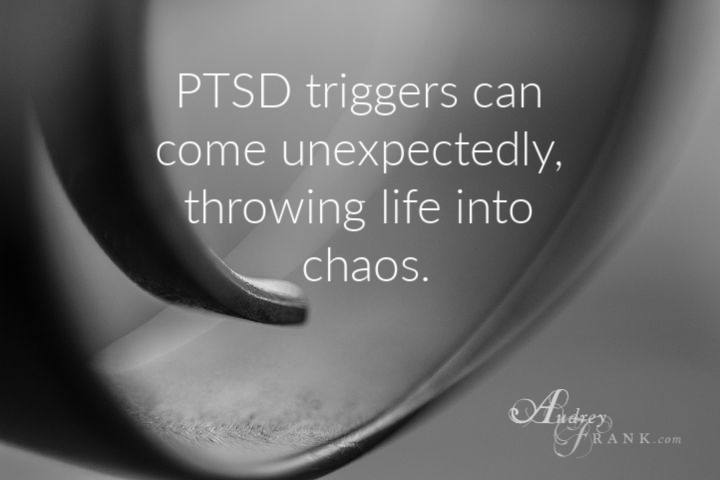Triggered: Identifying Post-Traumatic Stress Disorder
 @audreycfrank
@audreycfrank
Part One: When You are the One Suffering from PTSD
“Don’t trigger me!” one teen said to another as they dissolved into laughter. The phrase has become casual and funny in popular culture, but underneath the laughter there is a kernel of truth. For those who suffer from post-traumatic stress disorder (PTSD), a trigger can come unexpectedly, throwing them into a tailspin of fear and anxiety.
One of the most indelible memories of PTSD for me happened one clear morning in Africa when a trigger interupted my life, warping reality. The old green Scout was my rescue car that day, the only reliable source of transportation available to make the long trek from our African village across the rutted dirt road, through the river, and finally to the hospital two hours away. I was sick, and I needed to see a doctor. Our team leader came to the aid in his old truck, arriving outside our little mud house as my husband helped me gather my things and climb in.
The smooth vinyl seats were cracked and worn, with two narrow stitches harboring a wide one right down the middle. The smell of old dust and sweat assailed my senses and I began to panic. My breathing increased, my heart beat erratically and forcefully, and I began to search for a way of escape.
Examining the door handle, I restrained myself from lunging over my husband’s lap and jerking the door open for a desperate leap to freedom. Fear choked me and tears rose to my eyes. Rage welled up inside of me and I clinched my hands for fear of attacking the men in the car with me.
You may think I was overreacting to a dusty old truck and familiar, trusted friends. Or that perhaps whatever made me sick that day was distorting my reasoning abilities. What was actually happening was an acute episode of Post Traumatic Stress, pointing all the way back to traumatic events from my childhood that happened in an old Scout.
According to the Mayo Clinic, Post Traumatic Stress Disorder (PTSD) is a mental health condition that’s triggered by a terrifying event — either experiencing it or witnessing it. Symptoms may include flashbacks, nightmares and severe anxiety, as well as uncontrollable thoughts about the event. Many people who go through traumatic events have difficulty adjusting and coping for a while, but they don’t have PTSD — with time and good self-care, they usually get better. But if the symptoms get worse or last for months or even years and interfere with your functioning, you may have PTSD.
I had been trained to recognize PTSD and to take steps to overcome its effects on my daily life. I knew my body’s reaction that day in Africa was to the past, not to the present.
I took a deep breath and listed to myself what was true right then. I am safe. I can trust these people. I am an empowered, strong, adult, not a weak, victimized child. This truck is helping me get to the hospital, not trapping me. I am safe. I am safe. I am safe.
Slowly my breathing normalized, my heart slowed, my eyes cleared, my fists relaxed. I began to enjoy the sights of my beautiful present. I talked with the safe people surrounding me right then. I anchored myself deeply in the reality that held me right in that moment. I allowed the solid, steady truth of Now to replace the terror of Then.
There was a time in my life, however, when I did not always know what to do in these situations. For many years I was even blind to them. I lived life from crisis to crisis, always surging forward on the adrenaline of either dealing with crisis or anticipating it, preparing for it or remembering it. My physical and emotional reactions to life around me seemed real and necessary to survive.
I did not understand then that they were often reactions to present environmental triggers which reminded my body and my emotions of past extreme trauma. Thanks to loving and wise friends and counselors, I have walked a long journey to health and wholeness. I now know the difference between real crisis and the misplaced anxiety my body and emotions manufacture when they are threatened and reminded of past pain. I will continue to walk this path to wholeness my entire life. But now I am equipped.
Here are a few essential tools:
• Accurately Identify PTSD. I used to think my reactions, flashbacks and avoidance of certain places or things was something I could get over if I tried hard enough. The truth is that if untreated, PTSD can worsen, especially during life’s stressful seasons. It can also lead to other conditions such as depression. If you suspect you may suffer from Post Traumatic Stress Disorder, talk to your health care professional.
• Watch out for any emotional response that is greatly disproportionate to the present trigger event. For example, an appropriate response to a dusty and sweaty old truck might have been to complain or joke about the need for deodorant, but certainly not to feel rage and panic, wanting to jump out of the car after attacking its occupants. When our response out-measures the stimulus, it is almost always about the past.
• Recognize any unexpected physical responses in yourself. Sweating, clinching, tensing, sudden headaches, changes in breathing patterns or heart rate can all be signs of PTSD. The responses your body produces are most often responses you had at the time of the actual traumatic event, or wanted to have but were not allowed.
• Watch for unreasonable thoughts, especially thoughts that are accusatory or blaming toward people who are truly safe and trustworthy in your life. In the midst of a PTSD episode, even trusted, safe people may seem like the enemy to you. Your mind and body want to lash out, especially if it was not allowed to actually defend itself from the real perpetrator in the past. When this happens, it is best to briefly remove yourself from others and refrain from verbal engagement until you can remind yourself of what is true in the present.
• Remind yourself what is true right now. Go through a mental reality checklist: physical location now (in my example, I was in a truck driving through an African village), safety now (I was with people who were safe, who were helping me, not hurting me), who you are now (an adult in charge of her body, not a child).
• Talk to a safe person. Tell a trusted person in your life that you are having a PTSD response, and ask her to help you talk through what is true now. Ask her to pray for you and with you.
People of all walks of faith and levels of maturity struggle with Post Traumatic Stress Disorder. Praying on your own and trying to get through privately is not enough. PTSD can even distort one’s understanding of Scriptural truths.
PTSD can masquerade as mental illness and cause you to think you are hopeless and insane. It can cause extreme anxiety, disrupting one’s relationships with people and with God, diminishing one’s quality of life and ability to function. It can cause people to lose their faith and even their lives.
Seek help from your doctor, a licensed professional counselor, or a pastor trained in PTSD and familiar with its symptoms. There is no shame in this need. You would go to a doctor to set a broken bone and start you on the journey to wholeness again. In a similar way, those who suffer from PTSD have a broken reality that needs trained help to set it right again, to start them on the journey to wholeness and healing.
Professional help is one necessary component to gaining the knowledge and objective support the sufferer needs to see clearly through this pain. Such help in my own life has enabled me to clear my head and live more fully in the present. It has opened my heart to comprehend more deeply the safe and protective love of God and others in my life right now. It has enhanced my relationship with myself, others, and God.
Things can get better. Identifying Post Traumatic Stress Disorder is a major step in that journey.
Join me next week for Part 2: When Your Loved One Suffers From PTSD
Resources:
http://www.nimh.nih.gov/health/topics/post-traumatic-stress-disorder-ptsd/index.shtml
http://www.focusonthefamily.com/media/daily-broadcast/impact-of-ptsd-on-military-families-pt1
http://www.focusonthefamily.com/media/daily-broadcast/impact-of-ptsd-on-military-families-pt2
http://www.ptsd.va.gov/public/family/ptsd-and-relationships.asp
http://www.helpguide.org/articles/ptsd-trauma/post-traumatic-stress-disorder.htm#family
http://www.psychguides.com/guides/how-to-help-someone-with-post-traumatic-stress-disorder/
http://www.aacc.net/2013/07/26/treatments-for-ptsd-what-you-need-to-know/
http://www.crosswalk.com/blogs/jim-daly/things-to-remember-about-ptsd.html
https://porch.com/advice/home-design-lifestyle-changes-help-ptsd

No Comments